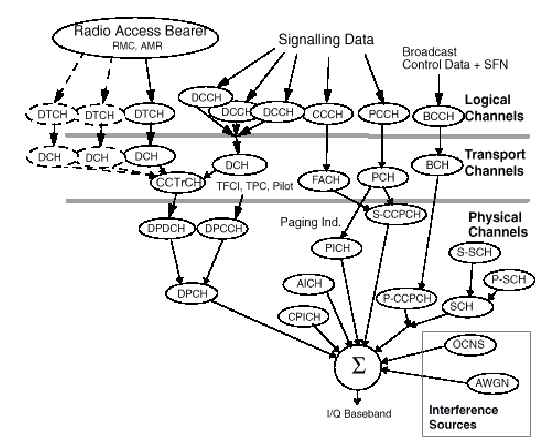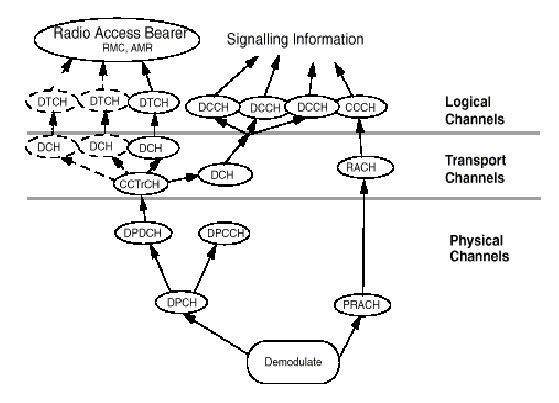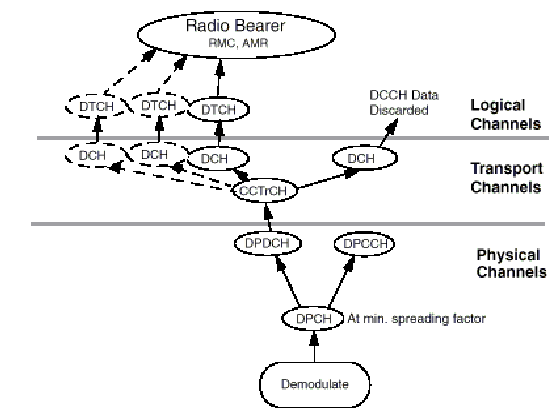Downlink and Uplink Channels Overview
The "Downlink" refers to a radio link for the transmission of signals from the test set to a UE (mobile station) while the "Uplink" refers to a radio link for the transmission of signals from a UE (mobile station) to the test set. Table below summarizes the downlink and uplink channels supported by the test set in Active Cell operating mode and the FDD Test operating mode, and the following figures show the channel structures respectively.
In FDD test operating mode, when
Channel Type
is set to
12.2k RMC + HSDPA
(
for lab applications or feature-licensed test applications only
), the test set also transmits up to 5 HS-PDSCHs (as determined by the
FDD Test "FRC Type" on page 1
setting) and up to 4 HS-SCCHs.
| Downlink Channels | Uplink Channels | Downlink Channels | Uplink Channels |
| CPICH | CPICH | ||
| S-CCPCH | |||
Downlink Channels
The downlink channels transmitted by the test set in Active Cell operating mode (see Active Cell Mode Downlink Channel Structure ) are different from the downlink channels in FDD Test operating mode (see FDD Test Mode Downlink Channel Structure ). To configure the downlink channel codes and levels, see
- Common pilot channel (CPICH): Used by the UE (mobile station) to find the primary scrambling code and to help determine its transmit power during open loop power control.
- Primary common control physical channel (P-CCPCH): Contains the broadcast channel (BCH) that normally provides system information to the UE. In FDD Test operating mode, this channel consists of pseudo-random bit sequence (PRBS) data and a valid system frame number (SFN).
-
Secondary common control physical channel (S-CCPCH)
Carries the signalling information used to set up the connection with the UE. This channel is not used in FDD Test Mode.
- Synchronization channel (SCH): Includes the primary and secondary synchronization channels (PSC and SSC) that contain timing information to allow the UE to synchronize to the test set (or base station).
-
Page Indicator Channel (PICH)
Used to alert the UE that it is possibly being paged. The UE must then read the Secondary common control physical channel (S-CCPCH) to determine if it is being paged.
In
Active Cellmode, the PICH contents are initially set to "no page" in all paging indicators. Once call origination is initiated, all of the page indicators in each valid access frame are set to indicate a page. The valid access frames occur at times specified by the DRX Cycle Length (CN Domain) setting. Once the UE has responded to the page, the paging indicators are returned to "no page."In
FDD Testmode, the PICH contents are determined by the DL PICH Data setting. - Acquisition Indicator Channel (AICH): Used in response to a UE's PRACH Preambles to indicate to the UE that it may continue with call setup. This channel is not used in FDD Test Mode.
- Dedicated physical channel (DPCH): Contains the dedicated physical control channel (DPCCH) which includes the transmit power control (TPC) and transmit format combination indicator (TFCI), and the dedicated physical data channel (DPDCH) which contains the user data.
Interference Sources on the Downlink
- Additive White Gaussian Noise (AWGN) - can be summed into the downlink signal to simulate interference from other cells when enabled. See Cell Power and AWGN Power .
- Orthogonal Channel Noise Simulator (OCNS) - used to simulate additional users on the downlink. OCNS is automatically enabled when the sum of the levels of all the enabled downlink physical channels is less than the cell power setting. See Orthogonal Channel Noise Simulator (OCNS) .
Uplink Channels
The test set recognizes two types of uplink physical channels, the Physical Random Access Channel (PRACH) and the Dedicated Physical Channel (DPCH). However, the Active Cell Mode W-CDMA Uplink Channel Structure is different from the FDD Test Mode W-CDMA Uplink Channel Structure .
- Physical Random Access Channel (PRACH) - used by the UE to request registration on the network. The test set only responds to the PRACH in Active Cell Mode.
- Dedicated Physical Channel (DPCH) - is the combination of the Dedicated Physical Data Channel (DPDCH) which carries the user data/signalling, and the Dedicated Physical Control Channel (DPCCH) which contains physical channel control information. In Active Cell Mode the test set will configure the Uplink DPCH by sending signalling information to the UE during Call Setup (see Channels Used for Call Setup ). In FDD Test Mode the Test Set assumes that the UE's uplink has been properly configured to match the expected configuration. The expected configuration is determined by the Channel Type setting.



